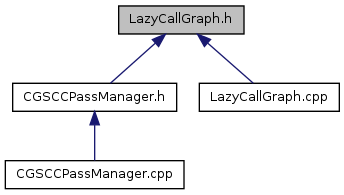#include "llvm/ADT/DenseMap.h"#include "llvm/ADT/PointerUnion.h"#include "llvm/ADT/STLExtras.h"#include "llvm/ADT/SetVector.h"#include "llvm/ADT/SmallPtrSet.h"#include "llvm/ADT/SmallVector.h"#include "llvm/ADT/iterator.h"#include "llvm/ADT/iterator_range.h"#include "llvm/IR/BasicBlock.h"#include "llvm/IR/Function.h"#include "llvm/IR/Module.h"#include "llvm/Support/Allocator.h"#include <iterator>

Go to the source code of this file.
Classes | |
| class | llvm::LazyCallGraph |
| A lazily constructed view of the call graph of a module. More... | |
| class | llvm::LazyCallGraph::iterator |
| A lazy iterator used for both the entry nodes and child nodes. More... | |
| class | llvm::LazyCallGraph::Node |
| A node in the call graph. More... | |
| class | llvm::LazyCallGraph::SCC |
| An SCC of the call graph. More... | |
| class | llvm::LazyCallGraph::postorder_scc_iterator |
| A post-order depth-first SCC iterator over the call graph. More... | |
| struct | llvm::LazyCallGraph::postorder_scc_iterator::IsAtEndT |
| Nonce type to select the constructor for the end iterator. | |
| struct | llvm::GraphTraits< LazyCallGraph::Node * > |
| struct | llvm::GraphTraits< LazyCallGraph * > |
| class | llvm::LazyCallGraphAnalysis |
| An analysis pass which computes the call graph for a module. More... | |
| class | llvm::LazyCallGraphPrinterPass |
A pass which prints the call graph to a raw_ostream. More... | |
Namespaces | |
| namespace | llvm |
List of target independent CodeGen pass IDs. | |
Detailed Description
Implements a lazy call graph analysis and related passes for the new pass manager.
NB: This is *not* a traditional call graph! It is a graph which models both the current calls and potential calls. As a consequence there are many edges in this call graph that do not correspond to a 'call' or 'invoke' instruction.
The primary use cases of this graph analysis is to facilitate iterating across the functions of a module in ways that ensure all callees are visited prior to a caller (given any SCC constraints), or vice versa. As such is it particularly well suited to organizing CGSCC optimizations such as inlining, outlining, argument promotion, etc. That is its primary use case and motivates the design. It may not be appropriate for other purposes. The use graph of functions or some other conservative analysis of call instructions may be interesting for optimizations and subsequent analyses which don't work in the context of an overly specified potential-call-edge graph.
To understand the specific rules and nature of this call graph analysis, see the documentation of the LazyCallGraph below.
Definition in file LazyCallGraph.h.
 1.7.6.1
1.7.6.1